Deforestation is the widespread clearing of forests and is a global issue with far-reaching consequences. While deforestation often brings to mind images of the Amazon Rainforest, it is crucial to recognise that it also affects other regions, including the United States of America. In this blog, we’ll explore the causes and impact of deforestation in the United States, examine notable case studies, and discuss ongoing conservation efforts to address this pressing environmental issue.
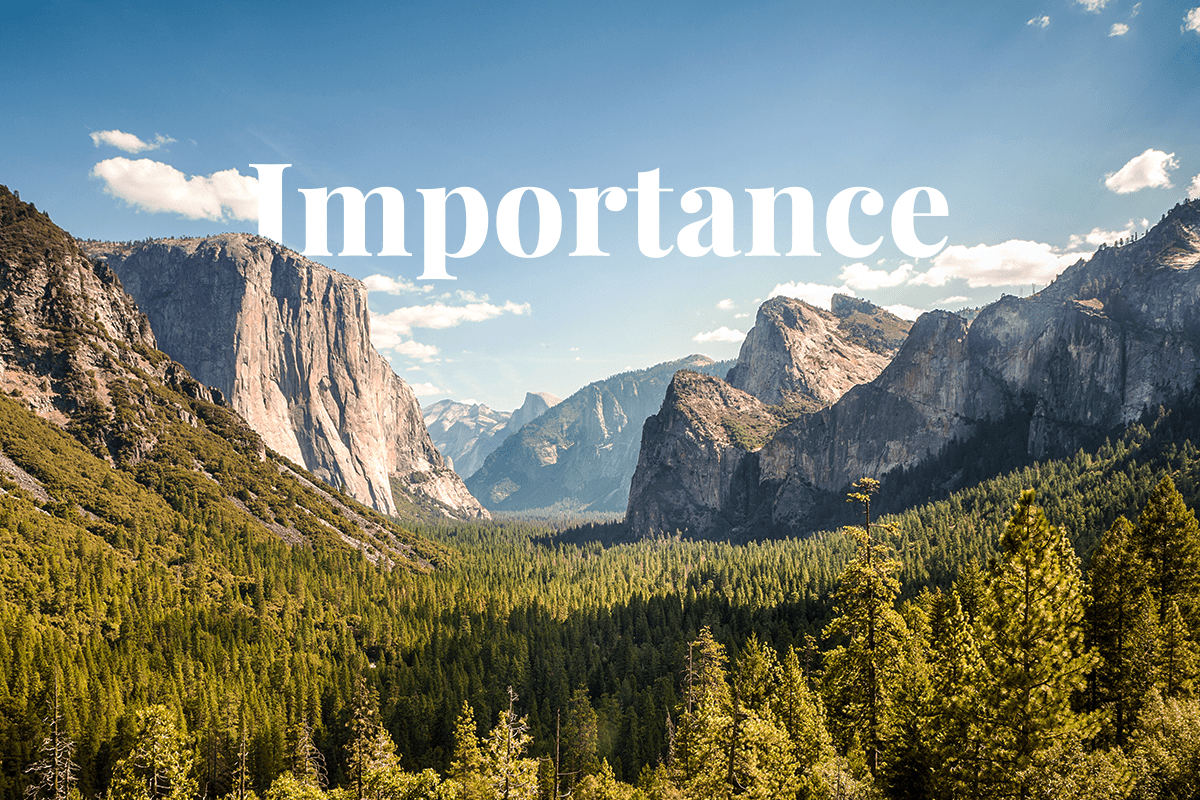 Yosemite Valley view, Yosemite National Park, California.
Yosemite Valley view, Yosemite National Park, California.
The United States boasts the world's fourth-largest forest estate, encompassing approximately 8% of global forests. With almost 766 million acres of forested land, forests cover about one-third of the country's total land area. From the breathtaking boreal forests of Alaska to the vibrant deciduous forests in the eastern region, the sprawling pine plantations in the southern states, the enchanting temperate rainforests along the West Coast, and even the tropical rainforests in Puerto Rico and Hawaii, the diversity of American forests is remarkable. While 69% of these forests are under private ownership, the remaining lands are carefully managed by local, tribal, state, and federal governments to preserve their ecological integrity.
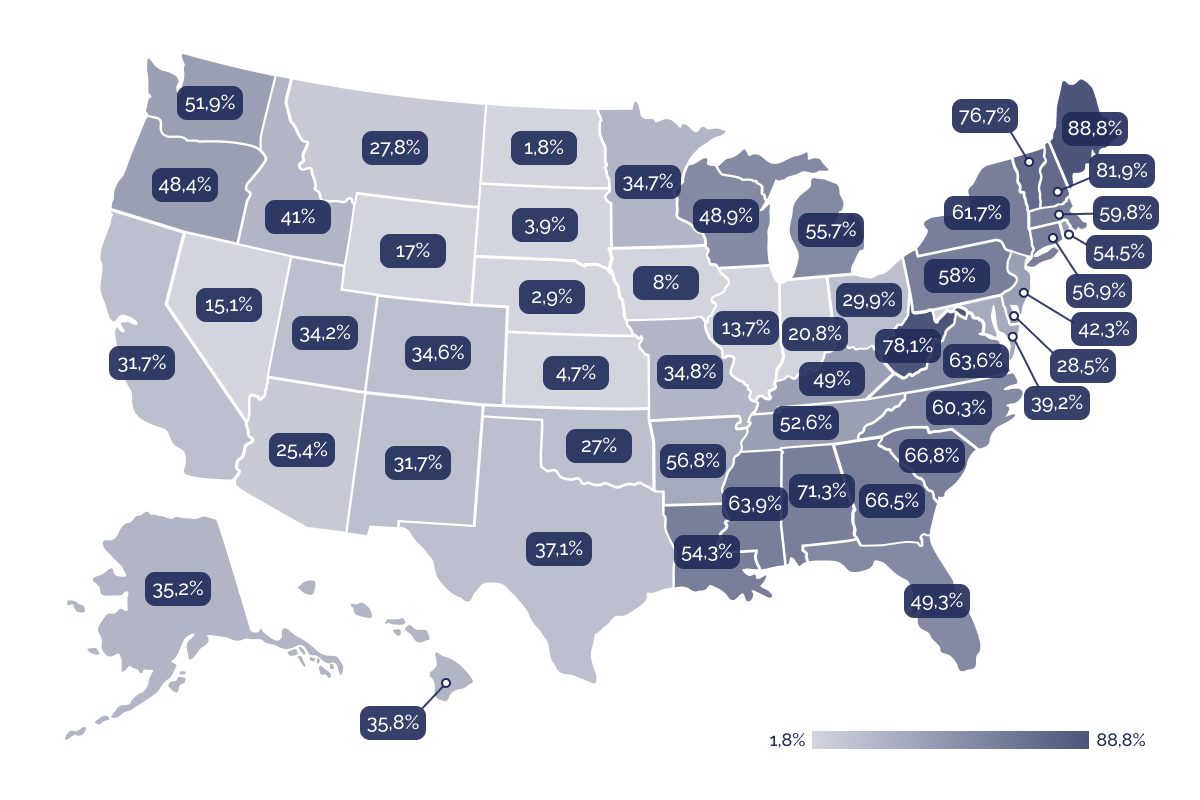 Percentage of forest cover in the United States; Source: https://wisevoter.com/state-rankings/most-forested-states/
Percentage of forest cover in the United States; Source: https://wisevoter.com/state-rankings/most-forested-states/
Causes of deforestation in the United States
In the United States, forested lands serve various purposes, with some designated for production and others preserved for conservation. However, a significant portion of forested lands falls under the category of multiple-use forestland, managed for a combination of production, recreation, habitat preservation, and aesthetic value.
The recognised timberland, primarily used for production, spans an extensive area of 521 million acres. Alongside these production-focused areas, there are reserved forests covering 75 million acres that are specifically preserved and not managed for timber harvest. These areas exclude protected areas like national forest roadless areas. The United States also boasts 187 million acres of other forest types, including woodlands, scrub forests, and urban forests.
Unfortunately, the United States faces deforestation at significant rates: In 2021 alone, it lost 4.22 million acres of forest, equivalent to 775 million tonnes of carbon dioxide emissions. There are many root causes of deforestation. Here are five of the most prevalent causes of deforestation in the United States:
-
Logging and timber industries: The demand for timber products drives extensive logging activities across the country, particularly in regions like the Pacific Northwest. The United States is one of the largest consumers and producers of timber globally, being the top global producer of industrial roundwood, wood pellets, and pulp for the paper industry. This contributes significantly to deforestation within its borders. It occurs most prevalently in Oregon, Washington, and Georgia.
-
Agriculture and expansion of croplands: To meet the growing demand for food and biofuel production, vast areas of forests are cleared for agricultural production, including soy, corn, and palm oil production. This practice is prevalent in the Southeastern United States, where forests are converted into croplands. Between 1982 and 1997, approximately 55% of land that transitioned into agricultural use originated from forested areas. This shift reflected a continued conversion of land from less intensive uses, such as forests, to more agriculturally focused uses, including cropland and pasture.
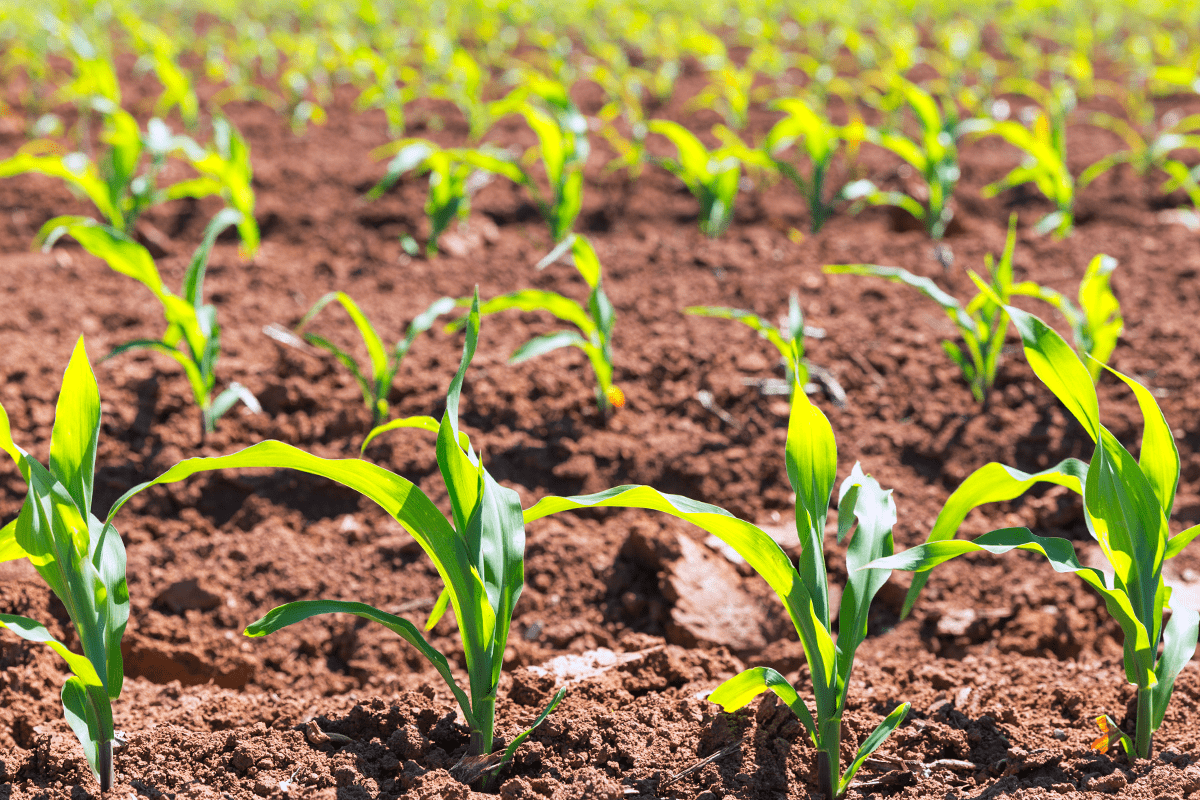 Corn fields in California agricultural plantation.
Corn fields in California agricultural plantation.
-
Urbanisation and infrastructure development: Rapid urban growth leads to the conversion of forests into residential areas, commercial spaces, and infrastructure projects, becoming a significant driver of deforestation. The construction of roads, highways, and industrial zones often involves clearing large swaths of forests, leading to habitat loss and fragmentation.
-
Natural disasters and wildfires: While natural disturbances like hurricanes, tornadoes, and wildfires are part of the ecosystem, their frequency and intensity have increased due to climatic instability. These events can result in significant forest loss and hinder reforestation efforts. California has become the most wildfire-prone state in the US, while on the other coast, Florida is the state most affected by hurricanes.
-
Illegal logging and unsustainable practices: Despite regulations, illegal deforestation activities persist, causing substantial damage to forests. Unsustainable practices, such as clear-cutting and selective logging, degrade forest ecosystems and contribute to deforestation leading to a loss of habitat for many wild animal species and environmental degradation.
The impact of deforestation in the United States
Deforestation has many far-reaching effects. Florida, Alaska, Alabama, Georgia, and Mississippi have experienced significant deforestation loss within the United States. Over the centuries, the country has witnessed the destruction of a staggering 75% of its virgin forests (since the 1600s).
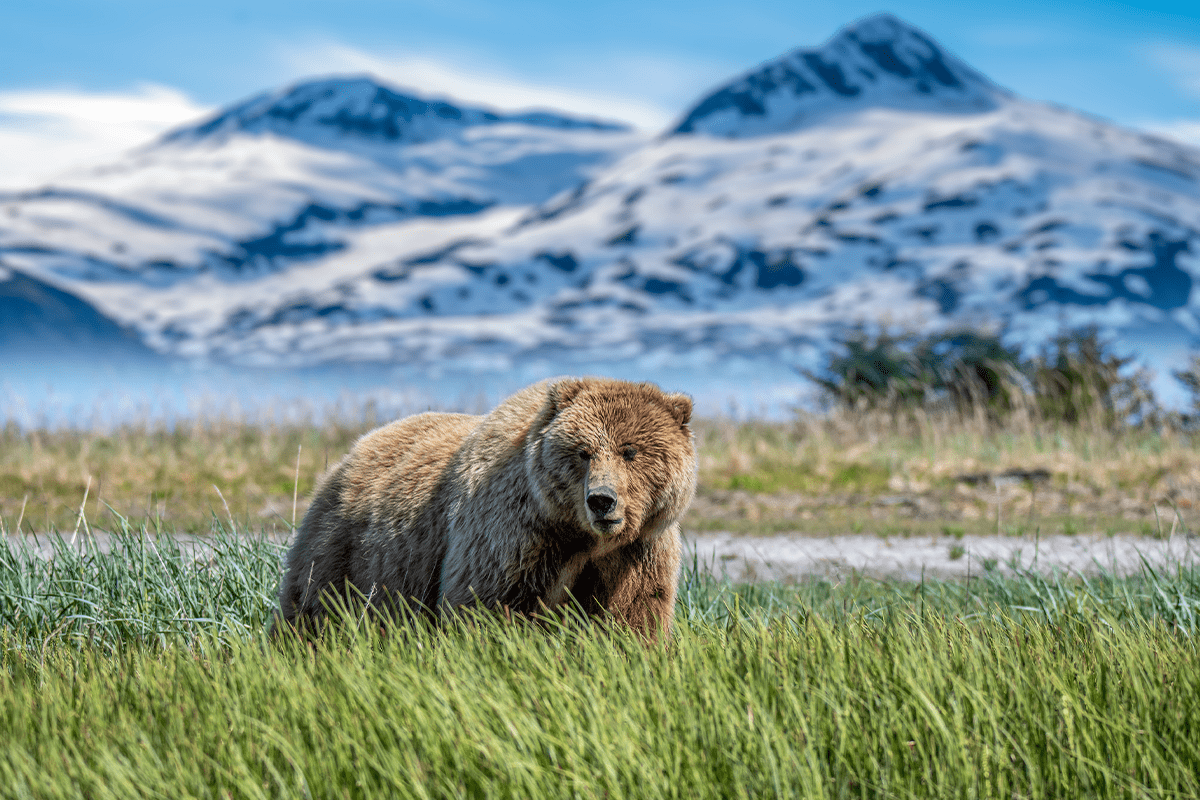 Brown bear, known as Grizzly bear in Lake Clark National Park and Preserve, Alaska.
Brown bear, known as Grizzly bear in Lake Clark National Park and Preserve, Alaska.
Between 2001 and 2020, the United States lost approximately 104 million acres of forests, resulting in a substantial 15% decrease in tree cover. These alarming statistics highlight the urgent need for conservation efforts and sustainable practices to address the ongoing issue of deforestation in the country and its effects. Here are some of the most prevalent effects of deforestation in the United States:
-
Loss of biodiversity and habitat destruction: Forests are home to a rich variety of plant and animal species. Deforestation disrupts ecosystems, leading to the loss of habitats and the endangerment or extinction of numerous species. The United States is home to diverse flora and fauna, some of which are unique to North America, such as the elk, bison, bald eagle, and California condor, making habitat preservation vital for biodiversity conservation.
Read more: Why are tropical rainforests important?
-
Increased carbon emissions: Forests act as carbon sinks, absorbing large amounts of carbon dioxide from the atmosphere and mitigating climatic instability. When forests are cleared, carbon is released back into the atmosphere, exacerbating the greenhouse effect. Deforestation in the United States therefore contributes to increased carbon and greenhouse gas emissions, impacting global climate patterns.
-
Soil erosion and degradation: Forests play a key role in soil conservation, preventing erosion, and maintaining soil fertility. Deforestation disrupts this balance, increasing soil erosion and nutrient depletion and decreasing agricultural productivity.
-
Water cycle disruption and increased flooding: Forests are vital for regulating the water cycle and ensuring the availability of freshwater resources. Deforestation disrupts this cycle, altering rainfall patterns and increasing the risk of flooding and droughts in affected areas.
Read more: Trees are nature's water managers: the importance of trees in water conservation
-
Impact on Indigenous communities and cultural heritage: Forests hold immense cultural and spiritual significance for Indigenous communities in the United States. Deforestation encroaches upon their ancestral lands, threatening their way of life, traditional knowledge, and cultural heritage.
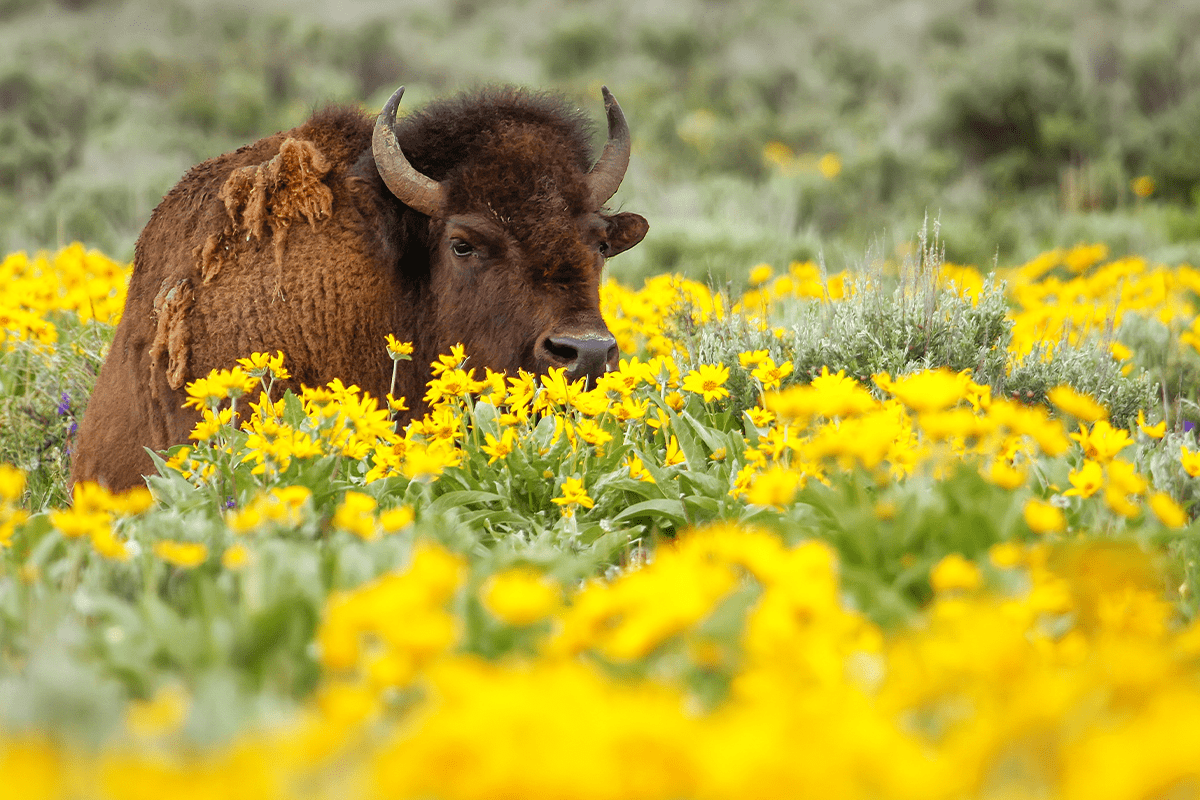 Bison lying in the field with flowers, Yellowstone National Park.
Bison lying in the field with flowers, Yellowstone National Park.
Case studies of deforestation in the United States
Deforestation takes many forms and carries many consequences. With such a biodiverse landscape in the US, it is essential to assess how deforestation manifests in various locations. Here are three case studies of deforestation in the United States:
Deforestation in the Pacific Northwest
The Pacific Northwest, renowned for its rich biodiversity, has been significantly impacted by extensive logging activities, resulting in habitat loss for various species, including the northern spotted owl.
Approximately 13% of the Pacific Northwest's old-growth forests were lost to logging within slightly more than 10 years, with most of the loss occurring on non-federal lands. NASA's recent satellite and space radar images vividly portray the decline of forests in Washington and Oregon—a consequence of development, agriculture, and extensive logging.
In this region, which includes California, nearly 50% of forests are owned by the US government, with federal lands containing around 67% of the highly carbon-rich and biodiverse old-growth forests. From 1994 to 2007, roughly 1.9% of old-growth forests on federal lands experienced loss. Notably, logging accounted for less than 0.5% of the loss (equivalent to approximately 32,000 acres), while the remainder (around 80,937 acres) was attributed to wildfires.
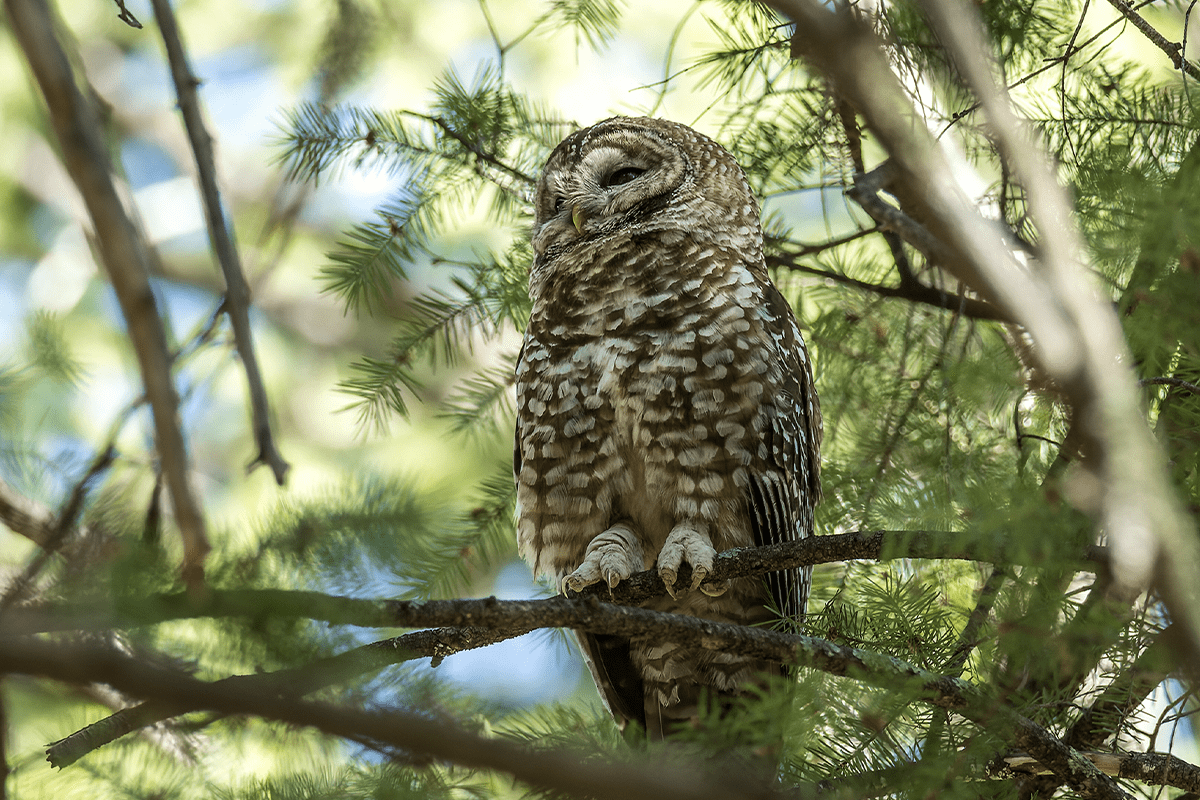 Spotted owl sitting on a tree branch.
Spotted owl sitting on a tree branch.
Deforestation in the Southeastern United States
The forest products industry in the Southern United States has played a significant role in forest clearing and the transformation of natural forests into monoculture pine plantations. According to a study on global forest cover loss published in ScienceDaily, the level of forest disturbance in Southeastern US forests from 2000 to 2012 was four times higher than that of Brazil.
Industrial logging in the subtropical forests of the Southeastern US was identified as a major driver of this trend. As a result, over 31% of forest cover in the Southeastern US has been lost or replaced mostly in favour of agricultural lands (for example, palm oil plantations). Landowners in this region use timber harvesting practices where trees are swiftly harvested and replaced, treating them as agricultural crops.
This approach has led to a highly dynamic landscape characterised by substantial tree loss and gain. Loblolly and slash pine, which were once a small portion of the natural pine forest, now dominate the Coastal Plain landscape. In contrast, the extensive longleaf pine savannas that were once abundant have been significantly reduced in size. Furthermore, the historical draining and ditching of wetland forests to make way for intensively managed pine plantations have altered the hydrological function of entire watersheds.
Deforestation in Alaska and the impact on wildlife
Climate change and the increased release of greenhouse gases in the atmosphere have led to the melting of Arctic ice, opening up new areas for resource extraction in Alaska. The loss of forests in the region, mainly due to wildfires, logging or road construction, threatens wildlife habitat for the caribou, polar bears, and migratory birds, with potential long-term ecological consequences. Alaska lost the largest amount of forest tree cover of all US states, losing almost 11% of its tree cover between 2001 and 2021.
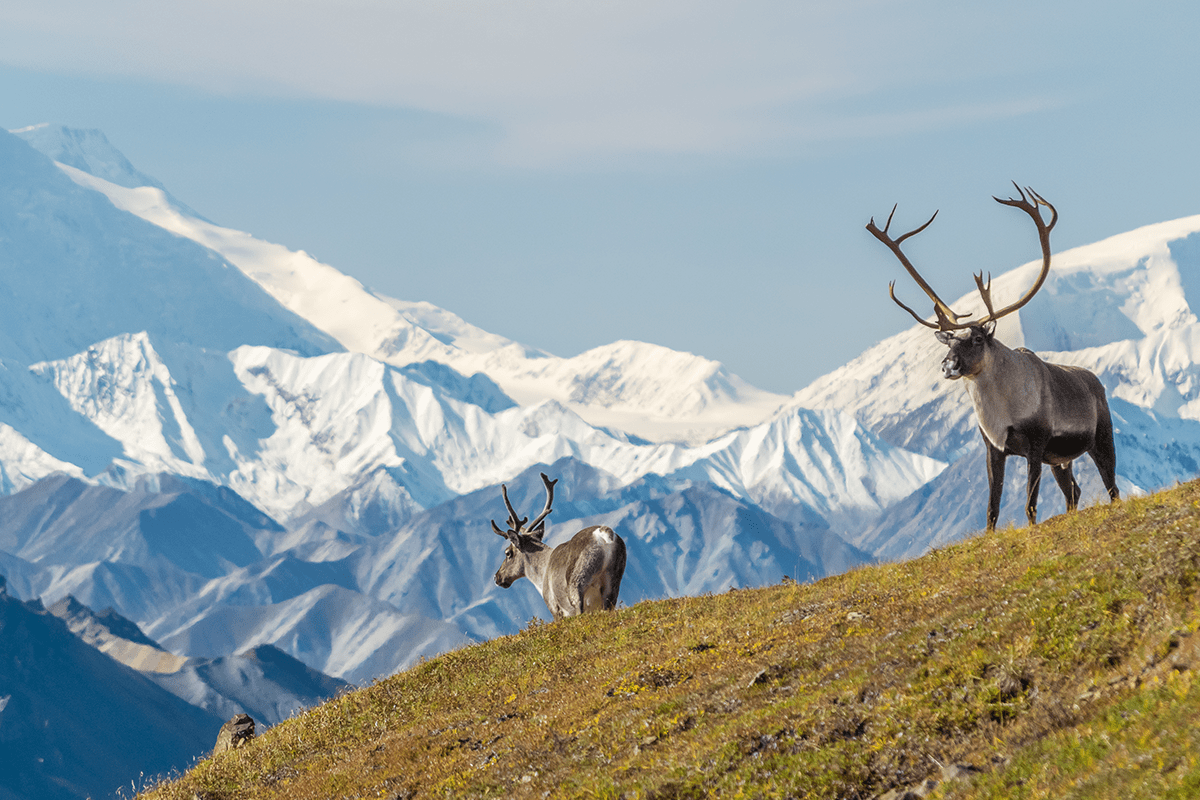 A couple of caribou in front of Mount Denali, Alaska.
A couple of caribou in front of Mount Denali, Alaska.
Extra: Deforestation in the Amazon Rainforest due to American companies: While not within the borders of the United States, American companies contribute to deforestation in the Amazonian tropical forest through activities such as cattle ranching and soybean cultivation.
Read more: Deforestation in the Amazon Rainforest: causes, effects, solutions
Conservation efforts and solutions
Deforestation remains a pressing global concern, requiring collective efforts to address its environmental impacts. Luckily, significant strides have been taken in the United States to combat this issue and preserve forest ecosystems, from government policies to efforts from conservation organisations. By exploring the multifaceted strategies and collaborative endeavours undertaken in the United States, we gain valuable insights into the fight against deforestation and the importance of sustainable forest management. Together, these efforts strive to safeguard our planet's invaluable forests for future generations.
Read more: Sustainable forestry practices combatting deforestation in Canada
Government policies and regulations
The United States has implemented various measures to address deforestation, including the National Forest Management Act and the Endangered Species Act. The government collaborates with indigenous communities, conservation organisations, and industry stakeholders to promote sustainable forestry practices to implement various solutions to deforestation.
Read more: Reforestation: 10 amazing benefits of planting trees
Reforestation and afforestation programmes
Organisations like the Arbor Day Foundation and the United States Forest Service undertake reforestation initiatives to restore and expand forest cover. Afforestation programmes focus on establishing new forests in areas that have been historically deforested.
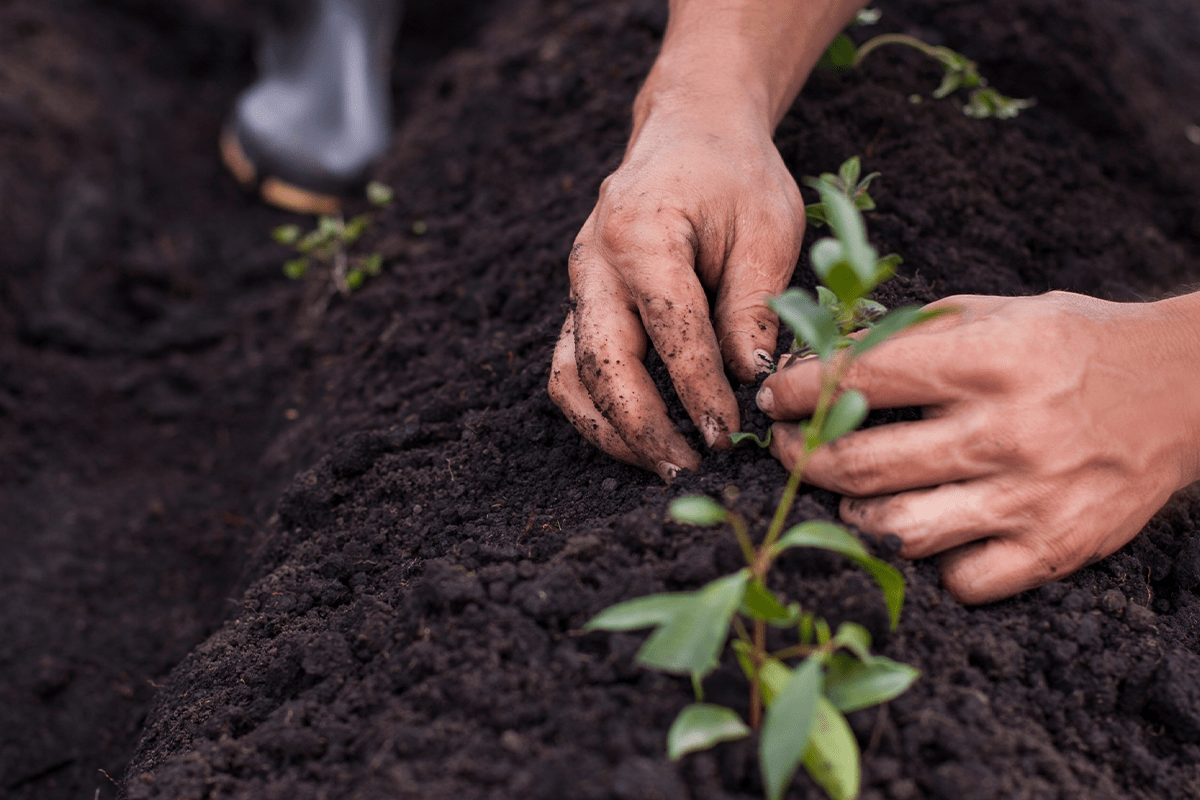 Planting new trees, Arbour Day celebration.
Planting new trees, Arbour Day celebration.
Sustainable forestry practices and certification systems
The Forest Stewardship Council (FSC) certification promotes responsible forest management, ensuring sustainable practices in timber harvesting and conservation. Encouraging the use of certified wood products supports the demand for sustainably sourced materials.
Conservation organisations and their initiatives
Nongovernmental organisations such as the Nature Conservancy and Rainforest Trust work to protect forests through land acquisition, conservation easements, and advocacy for policy change. Their efforts contribute to preserving critical habitats and raising awareness about deforestation.
Public awareness and individual actions
Educating the public about the importance of forests and the impact of deforestation is essential. Individuals can support conservation efforts by making sustainable consumer choices, reducing paper products and wood consumption, and participating in tree-planting initiatives.
Read more: Top 10 causes of deforestation
Challenges and future outlook
Finding a balance between economic development and forest conservation is a complex challenge. It requires sustainable land–use practices, responsible resource extraction, and support for alternative livelihoods for communities dependent on forest resources.
Read more: What is sustainable land management?
While progress has been made, the effectiveness of conservation initiatives needs continuous evaluation and improvement. Strengthening the enforcement of regulations, addressing illegal logging, and ensuring the participation of local communities is crucial for the long-term success of deforestation-combatting efforts. Another significant challenge to the success of conservation and reforestation initiatives is funding. Studies show much more funding is needed to combat biodiversity loss and deforestation. However, global investment, especially from developed countries like the United States, is needed to meet the funding demand.
Read more: Deforestation in Asia: a call for conservation
Sustainable forest management to combat the effects of deforestation and its current rates requires long-term planning, funding, ecosystem restoration, conservation, and multi-stakeholder collaboration to ensure the health and productivity of forests for future generations.
On the future outlook side, advancements in technology such as remote sensing, data analytics, and monitoring systems provide valuable tools for assessing drivers of deforestation and deforestation rates, identifying illegal activities, and implementing targeted conservation strategies. These advancements can thus assist in monitoring, assessing, and decreasing the current rates of deforestation.
Deforestation is a global issue that requires global action and collaboration between nations, sharing of best practices, and supporting initiatives like the United Nations' REDD+ programme (Reducing Emissions from Deforestation and Forest Degradation).
DGB Group’s commitment to the health of forests worldwide
At DGB Group, we firmly believe in the power of nature and the critical role of biodiversity in sustaining life on Earth. That's why our commitment to promoting biodiversity and conservation is at the heart of our reforestation and afforestation projects. Our projects are thoughtfully designed and managed to foster the growth of healthy and thriving ecosystems.
Through our initiatives, we actively contribute to enhancing biodiversity and supporting conservation efforts. With years of experience partnering with institutions and organisations worldwide, DGB has a proven track record of developing impactful carbon projects that benefit all stakeholders. These include landowners, local communities, private companies, government agencies, and non-governmental organisations.
By championing biodiversity and conservation through our large-scale reforestation and afforestation projects, DGB strives to make a positive difference in the health of forests worldwide. We firmly believe that by working together, we can protect and preserve these invaluable ecosystems for future generations. Join us in our mission to create a sustainable and thriving planet where nature's beauty and diversity are cherished and protected.


 Corn fields in California agricultural plantation
Corn fields in California agricultural plantation






